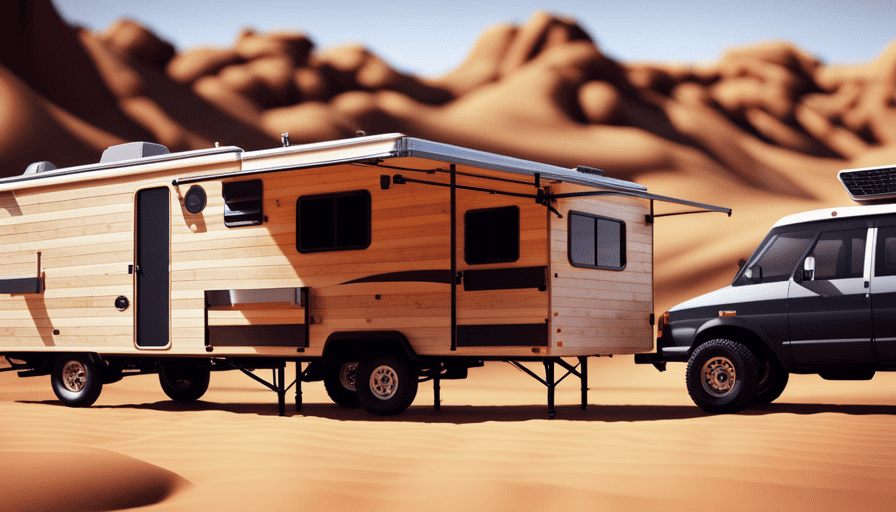Are you prepared to set off on your upcoming camping journey? Imagine the scene: the sun dipping below the horizon, a soft wind whispering amongst the trees, and the comforting crackle of a campfire.
But before you can fully immerse yourself in the great outdoors, there’s an important task at hand – tying down your camper. Just like a ship needs its anchor to stay steady amidst the rolling waves, your camper needs to be securely fastened to ensure a safe and enjoyable camping experience.
In this article, we will guide you through the essential steps of tying down a camper, sharing our knowledge and expertise gained from years of experience in the great outdoors. From assessing the terrain to choosing the right tie-down equipment, we’ll provide you with practical tips and tricks to ensure your camper stays firmly in place, allowing you to relax and enjoy all that nature has to offer.
So, let’s dive in and learn how to tie down a camper like seasoned adventurers!
Key Takeaways
- Assess campsite terrain and weather conditions before setting up the camper
- Choose the right tie-down equipment for stability and weight distribution
- Secure the camper’s wheels with proper tire pressure, wheel chocks, and locks
- Regularly inspect and maintain the tie-down system to ensure its effectiveness
Assess the Campsite Terrain and Conditions
Before setting up your camper, it’s important to assess the campsite terrain and conditions to ensure a secure and stable setup. Assessing weather conditions and evaluating ground stability are crucial steps in this process.
Start by checking the weather forecast for any potential storms or strong winds that could affect the stability of your camper. If there are high chances of adverse weather, it may be best to choose a different location or delay your camping trip.
Next, evaluate the ground stability. Look for any signs of uneven terrain, such as slopes or depressions, which could impact the balance of your camper. Avoid areas with loose soil or sand, as they can make it difficult to secure your camper properly. Instead, opt for solid ground like gravel or asphalt. Additionally, take note of any nearby trees or branches that could pose a risk in case of strong winds.
Once you have assessed the campsite terrain and conditions, it’s time to choose the right tie-down equipment. This will ensure that your camper remains securely in place even during adverse weather conditions.
Choose the Right Tie-Down Equipment
To ensure proper stabilization, it’s imperative to select the appropriate fastening gear for securing your recreational vehicle. When choosing the right tie-down equipment, there are a couple of key factors to consider: choosing the right anchor points and understanding weight distribution.
Firstly, it’s crucial to identify the anchor points on your camper that’ll provide the most stability. These anchor points should be strong and securely attached to the frame of the camper. Look for areas where the frame is reinforced or where there are dedicated tie-down points. By attaching your tie-down equipment to these strong points, you can ensure that your camper will stay securely in place, even in windy conditions or on uneven terrain.
Secondly, understanding weight distribution is essential for choosing the right tie-down equipment. It’s important to distribute the weight of your camper evenly across all four corners. This’ll help prevent any excess stress on certain anchor points and ensure that the camper remains stable during transport.
By choosing the right anchor points and understanding weight distribution, you can effectively secure your camper. Once the tie-down equipment is properly attached, it’s time to move on to the next step – securing the camper’s wheels.
Secure the Camper’s Wheels
Once you’ve locked the wheels in place, your camper will be as secure as a fortress on the move. To prevent camper movement during transit, it’s crucial to secure the camper’s wheels properly.
Start by checking the tire pressure to ensure it meets the manufacturer’s recommended level. Proper tire pressure is essential for maintaining stability and preventing tire blowouts on the road.
Next, use wheel chocks to secure the camper’s wheels. These small wedges are placed against the tires to prevent them from rolling. Position the chocks snugly against the front and back of each wheel, ensuring a tight fit. This will provide an additional layer of security and prevent any unwanted movement.
Additionally, consider using wheel locks or wheel clamps for added protection. These devices attach to the wheel and prevent it from rotating, making it nearly impossible for anyone to move the camper without your permission.
Once the wheels are securely locked in place, you can move on to the next step: using stabilizer jacks or leveling blocks. These tools help stabilize the camper and level it on uneven surfaces. But we’ll discuss that in the next section, where we’ll delve into the details of using stabilizer jacks or leveling blocks.
Use Stabilizer Jacks or Leveling Blocks
Now, let’s explore how you can maximize stability and level your camper using stabilizer jacks or leveling blocks.
To ensure a stable foundation for your camper, start by using chocks for added stability. Chocks are wedge-shaped devices that prevent your wheels from rolling. Place them snugly against the wheels on both sides of the camper to prevent any movement while you work.
Next, focus on proper weight distribution. This is crucial for maintaining stability and preventing swaying. Make sure to evenly distribute the weight across the camper by placing heavier items towards the center and lighter items towards the edges. This will help maintain balance and minimize any tilting or rocking.
Now that you have stabilized and leveled your camper, it’s time to attach anchor straps to solid objects. This will provide an additional layer of security in case of strong winds or other external forces. By attaching the straps to sturdy trees, posts, or other fixed objects, you can prevent the camper from shifting or tipping over.
With the camper securely stabilized and the weight properly distributed, you can now move on to the next step of tying down your camper.
Attach Anchor Straps to Solid Objects
Secure your camper by fastening anchor straps to sturdy trees or posts. This will create a firm grip that will keep your home on wheels grounded, like a rock in a raging river. Proper anchoring is essential to ensure that your camper stays in place, even during strong winds or uneven terrain. When tying down your camper, there are a few tie-down techniques that you should keep in mind.
Firstly, make sure to choose solid objects that can withstand the force exerted on them. Sturdy trees or solid posts are ideal for anchoring your camper. Avoid using objects that may be easily uprooted or damaged.
Next, attach the anchor straps to these solid objects using strong and durable materials. Ratchet straps or heavy-duty ropes are recommended for this purpose. Make sure to secure the straps tightly, ensuring that there is no slack that could cause the camper to shift.
Once the anchor straps are attached, adjust and tighten the tie-down straps to ensure a snug fit. This will provide extra stability and prevent any unnecessary movement. By following these tie-down techniques and properly anchoring your camper, you can enjoy peace of mind knowing that your home on wheels is securely fastened.
Now, let’s move on to the next step, where we’ll discuss how to adjust and tighten the tie-down straps for maximum security.
Adjust and Tighten the Tie-Down Straps
Make sure you cinch up and secure those straps nice and tight to keep your home on wheels steady and secure. Adjusting and tightening the tie-down straps is a crucial step in properly securing your camper. Here are three important techniques to consider:
-
Proper strap placement: Start by positioning the straps diagonally across the camper, attaching them to the anchor points on the solid objects. This will create a crisscross pattern that distributes the tension evenly. Avoid placing the straps too close to the edges of the camper to prevent damage.
-
Adjusting the length: Once the straps are in place, adjust their length to ensure a snug fit. You want the straps to be tight enough to prevent any movement, but not so tight that they cause strain on the camper or the anchor points. Find the right balance by pulling the straps firmly and then securing them.
-
Checking for proper tension: After tightening the straps, give them a gentle tug to check for proper tension. They should feel secure and provide resistance. If the straps feel loose or give too much, readjust and tighten them further.
By following these adjustment techniques and properly placing the straps, you can ensure that your camper stays securely tied down.
Now, let’s move on to the next step and check for proper tension and stability.
Check for Proper Tension and Stability
Once you’ve got those straps cinched up tight, it’s time to ensure your camper is rock-solid and as stable as a mountain.
To achieve proper tension and stability, it’s crucial to inspect your tie-down straps regularly. Start by checking that each strap is securely fastened and tightened, ensuring there is no slack or looseness. Give each strap a gentle tug to assess its tension. You want them to be snug and firm, but not overly tight to the point of strain.
Next, it’s essential to examine the stability of your camper. Walk around the perimeter and observe if there is any shifting or swaying. Look for any signs of movement or instability, such as loose corners or wobbling. If you notice any issues, readjust the tie-down straps accordingly to reinforce stability.
Proper tension and stability are vital for a safe and secure camper. You want to enjoy your camping experience without worrying about your camper toppling over. By ensuring your tie-down straps are tight and your camper is stable, you can have peace of mind during your travels.
As you consider using additional support devices, remember that they can further enhance the stability and security of your camper. These devices can include stabilizer jacks, wheel chocks, or even leveling blocks. Incorporating these extra measures will provide an extra layer of support and stability, giving you added confidence on your outdoor adventures.
Consider Using Additional Support Devices
Enhance the stability and security of your camper by considering the use of additional support devices, such as stabilizer jacks, wheel chocks, or leveling blocks. These devices are designed to provide extra stability and prevent your camper from rocking or shifting while it is parked.
One option is to use wheel chocks, which are placed on either side of the camper’s wheels to prevent them from rolling. This is especially important when parking on uneven terrain or inclines. By securely placing wheel chocks, you can ensure that your camper stays in place and doesn’t move unexpectedly.
Another useful support device is a tensioner. Tensioners are typically adjustable bars that can be attached to the frame of the camper and anchored into the ground. They help to distribute weight evenly and provide additional stability. By using tensioners, you can minimize any movement or swaying of your camper, making it feel more secure and solid.
Incorporating these additional support devices into your tie-down system will greatly enhance the stability and security of your camper. By using chocks and tensioners, you can prevent any unwanted movement or shifting.
In the next section, we’ll discuss the importance of regularly inspecting and maintaining your tie-down system to ensure its effectiveness.
Regularly Inspect and Maintain Tie-Down System
Don’t you just love the thrill of wondering if your camper will suddenly break free and take off on its own adventure? Well, to keep that excitement alive, be sure to regularly inspect and maintain your tie-down system.
Properly inspecting your tie-down system is crucial to ensure the safety and security of your camper while on the road or at the campsite. Start by visually inspecting all the components of your tie-down system. Check for any signs of wear or damage, such as frayed straps or loose bolts. It’s essential to pay close attention to the anchor points and make sure they are secured properly. Additionally, inspect the tension of the straps and make any necessary adjustments to ensure a tight fit.
Regular maintenance of your tie-down system is equally important. Clean the straps and hardware regularly to prevent dirt and debris build-up that can weaken the system. Lubricate any moving parts to ensure smooth operation and prevent rust or corrosion.
Aside from maintaining the tie-down system, campsite maintenance is also crucial. Clear any obstacles that may interfere with the proper functioning of the system, such as rocks or tree branches. Ensure that the anchor points are securely fixed to a solid structure, such as a concrete pad or sturdy tree.
By regularly inspecting and maintaining your tie-down system, you can have peace of mind knowing that your camper is safely secured. However, if you encounter any issues that you’re unsure how to handle, it’s always best to seek professional assistance.
Seek Professional Assistance if Needed
If you ever find yourself in a bind and need some expert help, don’t hesitate to seek professional assistance. When it comes to tying down a camper, there are times when it may be necessary to hire a professional.
While many campers can be securely tied down by following proper procedures and using the right equipment, there are situations that call for the expertise of a professional.
One such situation is when you’re unsure about the strength and stability of your tie-down system. If you notice any signs of wear and tear, such as frayed straps or loose connections, it’s important to have a professional inspect and repair the system. They have the knowledge and experience to identify potential issues and ensure that your camper is securely fastened.
Another reason to seek professional assistance is if you’re not confident in your own abilities to properly tie down a camper. Safety should always be the top priority, and if you’re unsure about the correct procedures or lack the necessary equipment, it’s best to leave it to the experts. They’ll have the proper tools and training to ensure that the camper is securely tied down and won’t pose a risk while on the road.
When hiring a professional, be sure to inquire about their qualifications and experience in tying down campers. It’s important to choose someone who’s knowledgeable and experienced in this specific area. Additionally, make sure they follow all safety precautions and adhere to industry standards. Safety should always be the top priority when tying down a camper, and hiring a professional can give you peace of mind knowing that the job is done correctly.
Frequently Asked Questions
How do I choose the right tie-down equipment for my camper?
When it comes to choosing tie-down equipment for your camper, there are a few factors to consider. First, determine the weight and size of your camper to ensure you select equipment that can handle the load.
Look for sturdy straps or chains with appropriate weight ratings. Additionally, consider the installation process. Opt for equipment that’s easy to install and secure, ensuring a safe and hassle-free camping experience.
What are stabilizer jacks and how do I use them to secure my camper?
Stabilizer jacks are like the sturdy foundation of a house, providing stability and peace of mind for your camper. They are essential for keeping your camper secure and level, preventing it from rocking or shifting while you’re inside. By using stabilizer jacks, you’ll enjoy a more comfortable and safer camping experience.
However, it’s crucial to avoid common mistakes like overextending the jacks or placing them on unstable ground. These precautions will ensure proper camper stability and security.
Can I use leveling blocks instead of stabilizer jacks to secure my camper?
Leveling blocks and stabilizer jacks serve different purposes when it comes to securing a camper. While stabilizer jacks are specifically designed to provide stability by reducing the movement of the camper, leveling blocks are primarily used to level the camper on uneven ground.
While leveling blocks can help to some extent in stabilizing the camper, they may not be as effective as stabilizer jacks. Stabilizer jacks offer better stability and can handle more weight, but leveling blocks can be a convenient and cost-effective option for minor adjustments.
How do I properly adjust and tighten the tie-down straps on my camper?
Proper tensioning techniques are crucial when adjusting and tightening tie-down straps on a camper. Firstly, make sure the straps are securely attached to the camper and the anchor points.
Then, start by tightening the straps evenly on both sides to prevent any imbalances. It’s important to maintain an appropriate tension, neither too loose nor too tight.
Common mistakes to avoid include overtightening, which can damage the camper, and insufficient tension, which may result in instability during travel.
What are some additional support devices that I can use to enhance the stability of my camper?
When it comes to enhancing the stability of your camper, there are a few additional support devices that can make a significant difference.
One option is to use stabilizer jacks, which provide extra support and prevent the camper from rocking.
Another useful device is a sway control system, which helps minimize the side-to-side movement while towing.
These additional support devices, along with properly adjusted tie-down straps, will greatly improve your camper’s stability and ensure a safe and enjoyable travel experience.
Is the Process of Tying Down a Fifth Wheel Camper Different from Tying Down a Regular Camper?
When it comes to tying down a fifth wheel camper, the process differs from tying down a regular camper. The unique design and hitching mechanism of a fifth wheel camper require specific techniques and equipment for proper securing. From using kingpin locks to stabilizing jacks, tie down fifth wheel camper to ensure safe travels and a stable camping experience.
Can the Method of Tying Down a Camper Also Help in Getting Into It If Locked Out?
If you find yourself locked out of your camper, the method of tying down a camper could potentially help you get back in. By using the techniques and tools commonly used to secure campers, you may be able to apply them to the door lock to gain access. Learn how to unlock camper door for emergency situations.
Conclusion
In conclusion, tying down a camper is essential for ensuring its stability and security while on the road or at a campsite. By carefully assessing the terrain and using the right tie-down equipment, such as anchor straps and stabilizer jacks, you can create a strong and reliable system.
Regular inspections and maintenance are also crucial to guaranteeing the safety of your camper. If you’re unsure about the process, don’t hesitate to seek professional assistance. Remember, taking the time to properly tie down your camper will give you peace of mind and a worry-free camping experience.










